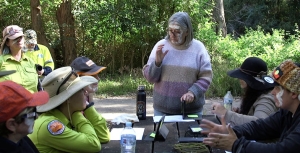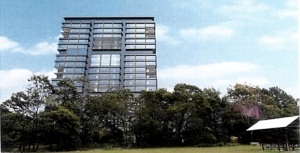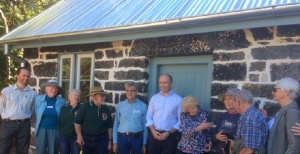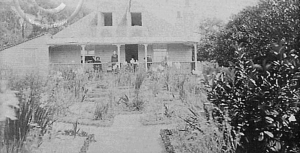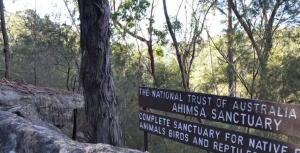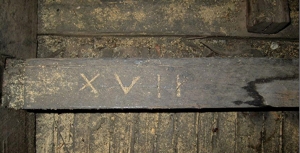Displaying items by tag: Lane Cove National Park
Dharug women's-led cultural burn at Browns Waterhole
One initiative that relates to the Durumbura project was the cultural burn near Browns Waterhole that took place in April 2024. Dharug women and allies worked together to undertake the first (since earliest colonisation days) Dharug women’s-led cultural burn. The information in this story comes from Regenavitis, the newsletter of the Friends of Lane Cove National Park.
The cultural burn originated from an invitation and funding from the Department of Planning and Environment’s Cultural Fire Management Team to the Dharug Yanama Budyari Gumada Collective. Macquarie University was also involved with the management of the burn. It is the first time Dharug women have been invited by a government department to restore Dharug cultural knowledges, language, and practices through fire, as a Caring for Country initiative so close to the inner city.
It was actively supported by a variety of Dharug community members as well as the NPWS, Friends of Lane Cove National Park, the three relevant local councils (Hornsby, Ku-ring-gai and Ryde) and the Rural Fire Service. It took about four years to plan the project including preparing a review of environmental factors and developing the burn plan.
The journey involved Dharug women holding a women’s camp in May, 2023, thanks to Ryde Council permitting Dharug women to camp at Waterloo Park – another first! Over the three days of the camp, Dharug women renewed cultural connection to Ngurra/country, engaged in ceremonial practices, storytelling, yarning, weaving, made place-based art, did some tools-based training with NPWS, and engaged in digital data collection thanks to Macquarie University scientists. In the process, they were able to establish the presence of swamp wallabies, bandicoots, goannas, turtles, gudgeons, diamond pythons, echidnas, a large variety of culturally important plants, and, of course, ever-present multitudes of sulphur-crested cockatoos, bell minors, kookaburras, various finches, parakeets, and other important bird species. Soil testing, before and after the burn has also been undertaken to determine changes in soil quality.
Originally it was supposed to be completed by 2023, but due to COVID and poor weather conditions, the burn was delayed until 2024. As such the undergrowth grew in height from around 1 m in 2021 to nearly 2 m in 2024. Nevertheless, the delay allowed for greater time to plan and budget. In March, 2024, Dharug women and allies came together to prepare the site for the burn and it was completed in April. It will be interesting to observe the impact of the burn on the forest ecology in coming years.
Group’s summary of the experience was:
While Dharug women have undertaken the cultural burn according to our cultural priorities of nurturing Ngurra (her soils, plants, animals and other presences), we recognise that based on the contemporary context, working collaboratively together with our allies enables us to continue our cultural ways of knowing, being and doing, as well as bringing others along the journey to establish sustainable futures in the city. Undertaking our cool-fire burn approaches mitigates the threat of mega-fires in the Durrumburra Dhurabang (Lane Cove River) valley, and simultaneously restores and strengthens an appreciation of the values that caring for Ngurra/country enacts.
Eden Gardens 18 storey tower development is refused
Back in December 2022 the Sydney North Planning Panel rejected a DA by the owner of Eden Gardens (the Ainsworth family, registered as Thunderbirds Are Go Pty Ltd) on Lane Cove Road, Macquarie Park to build an 18 storey office tower and other facilities. This plan was originally rejected by Ryde Council in March 2021. The applicant made no attempt to address the many issues given for the council’s rejection such as traffic, visual impact and impact on Lane Cove National Park (LCNP) next door. Therefore, the panel’s rejection decision was expected.
The next step was inevitably a Land and Environment Court hearing. This occurred in February 2024. It has taken until September, more than six months later, for the court commissioner to make a final ruling. To everyone’s relief, the application was refused.
The judgement centred on the legal considerations of:
- a merit contention of whether the visual impact was acceptable
- a jurisdictional prerequisite that the traffic impact would satisfy the terms of the Transport and Infrastructure SEPP
Submissions on environmental impacts
Several representatives with an interest in LCNP made presentations to the court hearing such as the NPWS, Friends of Lane Cove National Park, 416 Group, STEP and aboriginal cultural and heritage representatives.
Ryde Council’s submission also made several objections to the impacts on LCNP:
The development creates an unacceptable interface with LCNP, impacting on fauna habitat values, vegetation integrity, aquatic ecological values with the jarring building height resulting in significant visual impacts upon sensitive surrounding areas. These impacts are inconsistent with the zone objectives of C1 National Parks and Nature Reserves within the Ryde LEP 2014.
The judgement made little reference to the environment. Negotiations prior to the hearing did lead to the addition of a condition of consent in relation to light spill. The only other environmental consideration was the impact of shading on an area of endangered Duffys Forest near the development that was discounted because it applied only during a short period of winter. Other issues raised such as risks to birds from reflection of sunlight off the tower, light disturbance to nocturnal animals or bushfire evacuation were not covered in the judgement.
There is going to be increasing pressure for development abutting bushland that will increase bushfire risks and impacts on wildlife. It is concerning that the legal process does not seem to give these issues enough consideration. Legal judgements usually quote extensively from other precedents that relate to past cases. Environmental issues are evolving all the time, especially the impacts of climate change. How can we progress the interest of the natural environment in this backward-looking situation?
The main issue – traffic
The development application (LDA2021/0095) was for alterations and additions to the existing garden centre and construction of an 18 storey office building including car parks with a total of 539 car spaces and additional dining space. All these aspects of the development will obviously generate more car movements. The garden centre is to remain in place.
A lot of the court hearing processes related to options for road access modifications and a proposed pedestrian bridge over Lane Cove Road. Nevertheless, the commissioner commented that the application process was fragmented in relation to this most important issue. She commented:
I observe, merely by way of comment, that none of the parties seem to have properly grappled with the status of the relevant roads adjoining the site until very late in the proceedings including up to and during the hearing.
Basically, the applicant contended that there would be no adverse impact on classified roads, namely Lane Cove Road and the M2 access ramps. When Ryde Council and Transport for NSW raised this issue they made an attempt to respond by proposing to build a pedestrian bridge over Lane Cove Road from near Fontenoy Road to Eden Gardens. The commissioner dismissed this as a ‘red herring’. It was a half-baked idea. Several trees would have to be removed that currently shield the unit blocks on the western side. It would not help commuters walking from the Metro Station as they would still have to cross the M2 link roads somehow. A few residents near Fontenoy Road might have benefitted, that is all.
The applicant suggested some options for easing congestion at the access to the site and intersection with Fontenoy Road. The commissioner considered that the modelling demonstrated that, even with the implementation of mitigation measures such as extra turning lanes, the volume of traffic generated by the development would have clear adverse effects on the safety, efficiency and ongoing operation of the M2 and Lane Cove Road.
Visual impact
The applicant’s experts argued that the tower was desirable because:
A tower form with its small footprint enables activation of the ground plan and uses that continue the functions that the community currently enjoy on the site.
They are also taking advantage of the situation that there is no height limit for the site specified in the Ryde LEP. There is however a maximum floor space ratio 1:1. The proposed development would have a floor space ratio of 0.996:1!
Four aspects of the obvious visibility of the 18 storey tower (80 m high) were considered:
- Consistency with the urban landscape as defined by the objectives of the Ryde LEP. The court decided that was compatible with the appearance of the area even though the tower would be 60% higher than the nearest tall buildings on the southern side of the M2.
- Its proximity to LCNP. The site is next to the Tunks Hill Picnic Area so one would expect an 80 metre high tower would have a big impact. Some experts argued that the picnic area is not totally immersed in the national park. Unfortunately, the LCNP website states that one of the features of the area is its ‘great views of Chatswood’. The fact that these are very distant views with dense forest in the foreground did not have any relevance to the court.
- Its proximity to other parts of LCNP is dismissed on the grounds that it would not be visible from other picnic areas or recognised walking tracks further into the park, where it would be screened by topography. This ignores the topography aspects for all the residents on the northern side of LCNP.
- Visibility to road users. Current views for drivers along Lane Cove Road, de Burghs Bridge and the M2 can enjoy a vista of bushland when travelling near the Eden Gardens site. Town planning experts provided differing views, one that the tower will have an adverse impact, another said the view would only be fleeting for cars on the M2 and there are already numerous views of high development nearby. The commissioner considers the impact to be acceptable. So much for the idea that cumulative impact of adding another high rise interruption to bushland views along the M2 is an intrusion for many people.
On these grounds the arguments about visual impact were deemed to not merit the refusal of the DA.
Friends of Lane Cove National Park Celebrate 25 Years
On 25 May the Friends of Lane Cove National Park put on a special celebration. They were founded in 1994 after major bushfires burnt out large areas of the park and exposed the bushland to weed invasion. They have been working for 25 years to restore the bushland of Lane Cove National Park together with the NPWS staff.
The occasion was also the official opening of Jenkins Kitchen after its restoration using a NSW government Heritage Near Me grant and resources from the Friends, their time and money, to restore the interior and set up displays of historical and wildlife items. The building built in 1855 is believed to be the oldest in Ku-ring-gai.
The Early Days in what is now Lane Cove National Park
The early European history of the area that became Lane Cove National Park could be said to stem from an exploratory visit to the Lane Cove River by George Caley in 1805. Caley was employed as a plant collector by Joseph Banks and was the first person to make a systematic study of eucalypts. He reported on the quality of the trees in the Lane Cove River valley and it is thought that as a result a convict timber camp was set up at what later became Fiddens Wharf.
One of the convicts employed at the camp was William Henry. He arrived in 1801 on the Earl Cornwallis, and no doubt obtained a good knowledge of the valley while working as a timber getter. After Henry was emancipated Governor William Bligh promised him a grant of 1,000 acres in an area which now includes much of the lower park and West Lindfield. Henry took up the grant and started a vineyard on a portion of the area. Unfortunately for him Bligh became somewhat distracted with the Rum Rebellion, the grant was never confirmed and eventually around 1850 Henry was thrown off the land as the government of the day prepared to sell it.
Some say that another famous Australian identity, John MacArthur had schemed to ensure that William Henry suffered because he had supported Bligh during the rebellion.
However, that was not the end of his family’s connection, his granddaughter Maria married Thomas Jenkins and in 1852 they purchased a portion of the land originally held by her grandfather. It was this family who held the property right up until 1937 when it was purchased by the government to form the basis of the national park.
The farm or orchard was known as Millwood, the house Waterview and the small stone building we now know as Jenkin’s Kitchen was built around 1855, separately from the house, as was often the case at that time when there was a fear of fire burning down the main building. Ironically the main building burnt down in 1943 after the incorporation of the area into the park, and although the kitchen has been affected by fire it is still with us.
After the recent renovations, which include a new roof and extensive work to the sandstone, there is every hope that it will remain as a focal point at the park headquarters for many years.
Invitation
Congratulations to STEP on reaching the milestone of the 200th issue of your magazine.
We at Friends of Lane Cove National Park also have a milestone coming up: the 25th anniversary of our founding. Many of you will know that this came about after the devastating fires in early 1994. However, that was not the start of bushcare in the park, a dedicated group had already been working in Carters Creek since 1991.
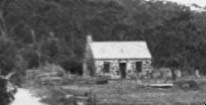 On 25 May we are gathering at the park to celebrate our 25 years and also to officially open Jenkins Kitchen which Friends have renovated with the aid of a Heritage Near Me grant. The grant is particularly designed to return heritage buildings to a form that can be accessed by the public. In this case the building, which is thought to be the oldest building in Ku-ring-gai, will be used at an interpretation centre illustrating its past use as a kitchen while acting as a source of information about the flora and fauna of the park.
On 25 May we are gathering at the park to celebrate our 25 years and also to officially open Jenkins Kitchen which Friends have renovated with the aid of a Heritage Near Me grant. The grant is particularly designed to return heritage buildings to a form that can be accessed by the public. In this case the building, which is thought to be the oldest building in Ku-ring-gai, will be used at an interpretation centre illustrating its past use as a kitchen while acting as a source of information about the flora and fauna of the park.
We would like to extend an invitation to anyone who has been a volunteer in the park or member of Friends of Lane Cove National Park in the past (and who we may have lost contact with) to come along and help us celebrate.
We will meet near the park headquarters at noon. Refreshments and a barbeque lunch will be provided, and it will be a good chance to catch up with old friends.
If you intend to come, please let us know at This email address is being protected from spambots. You need JavaScript enabled to view it. to help us with the catering.
Photo at the top of the page is Jenkin’s homestead 1895 (photo Ku-ring-gai Library)
Tony Butteriss
Ahimsa: A Story of Bushland Protection
Walking along hand built stone paths into the bushland property Ahimsa is a step back in time and an inspiration for the future. It is also a remarkable testament to the former owner Marie Byles.
Gifted to the National Trust of Australia (NSW) over 40 years ago by Marie Byles, this 3.5 acre bushland property at Cheltenham in the Upper Lane Cove Valley is now listed as a state heritage item. Ahimsa adjoins Lane Cove National Park and is part of a large area of bushland surrounded by urban development.
Marie Byles was a visionary woman well ahead of her time. She was the first female to practice law in NSW, a mountaineer, explorer and avid bushwalker, a committed conservationist, a feminist, author, and original member of the Buddhist Society in NSW.
Marie was a passionate protector of bushland, whether from development, roads, weeds, or uncaring government officials. In 1938 she built a simple fibro and sandstone cottage on the property for her home on a rock ledge overlooking the beautiful surrounding bushland. The name of her home Ahimsa means harmlessness, a Buddhist and Hindu spiritual doctrine and Sanskrit word. This name reflects her belief that we are not separate from the world around us, and the natural environment should be respected and protected from harm.
Later in 1947, Marie designed the nearby Hut of Happy Omen which was built by friends and volunteers to accommodate a range of people and activities, including visiting Buddhists, bushwalking groups, conservationists and social gatherings.
Ahimsa is little changed in over half a century, and represents the physical expression of the life and values of Marie Byles. She left the land to the National Trust to protect its bushland in perpetuity, and in the public interest. The significance of the property is its realisation of Marie’s lifestyle and beliefs, and strong connection with current ideas about sustainable living, mindfulness, meditation and protection of the natural environment.
Ahimsa is a place that is important in the story of the conservation of Sydney’s bushland. An easy walk from the railway station, it is a place of peace away from Sydney’s hustle and bustle. The Hut of Happy Omen is available for use by people and groups compatible with the values of the property, by arrangement with the National Trust.
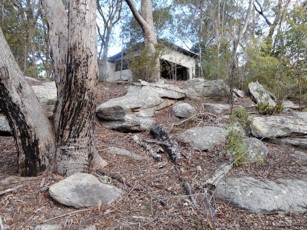
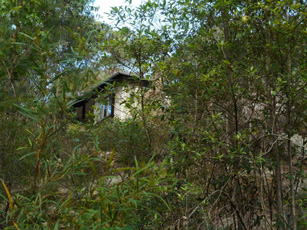
Friends of Ahimsa is working with the National Trust of Australia (NSW) to support future management of the property and to make Ahimsa accessible as a place that tells the story of its former owner and contributes to the realisation of Marie Byles’ dreams and values.
Children’s Art at Ahimsa on Sunday 28 April 2019 provides an opportunity for children between 7 and 11 years of age and their carers to appreciate the Ahimsa bush.
Although Ahimsa faces challenges for the future, including how to effectively maintain its bushland, heritage values and buildings, Marie Byles’ vision of simple living and protection of nature remains an inspiration. It is hoped that future generations will continue to use Ahimsa to learn about and reflect on Sydney’s bushland heritage, and the people who were instrumental in protecting it.
To find out more about Friends of Ahimsa, the conservation and management of the property, or to be placed on the Friends of Ahimsa contact list for future events and activities, please email This email address is being protected from spambots. You need JavaScript enabled to view it..
Martin Fallding has a lifelong association with Ahimsa as a neighbour and family friend of Marie Byles. He has had a long involvement in bushland conservation and is currently the president of Friends of Ahimsa.
Timbergetting in the Lane Cove Catchment
In February 1805 botanist George Caley (sent out by Sir Joseph Banks) made an exploratory trip from Pennant Hills across the upper catchment of the Lane Cove River and reported on the fine timber. Nine months later Governor King issued directions for a gang of convicts to be employed at the North Shore to procure ship timber.
A timber carriage with eight draught bullocks was conveyed to the work site in the government punt, attended by a competent number of hands. Thomas Hyndes, one of the original grantees of land at Wahroonga, and clerk and overseer to the superintendent of camp and gaol gangs, probably accompanied them to the site on the flat at Fiddens Wharf, on the northern side of the Lane Cove River at Killara.
From an administrative point of view the Lane Cove camp was a problem. It was located distant from Sydney and run by overseers who had not been tried and tested in Sydney under the watchful eye of the principal superintendent.
There were three overseers appointed and dismissed from Lane Cove between 1808 and 1814. It was during 1809 to 1814 that the camp was most productive. The main timbers logged were Blackbutt, Blue Gum and Iron Bark for building purposes and Casuarina for roof shingles.
Governor Bligh prepared material to erect some necessary buildings including a large barrack for soldiers and timber from the North Shore Camp was used to build the Parramatta Store, completed by the end of 1809, and the Commissariat Building in Sydney, begun in 1809. These no longer exist.
Macquarie visited the camp in May 1810 and found that the timber in the Lane Cove Valley between Hornsby and Roseville was getting scarce and observed that the camp would need to be moved elsewhere.
Macquarie’s first major project using Lane Cove timber was the building of a Light Horse Barracks and a new hospital, now Parliament House and The Mint. The numbers of draught cattle at Lane Cove were trebled in preparation for this major project.
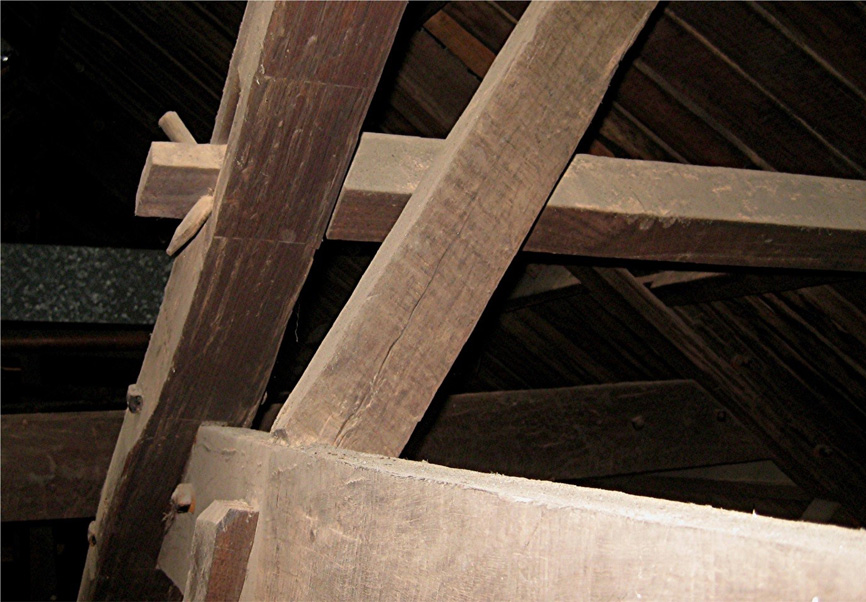
Rafters at the southern end of The Mint showing a purlin (top horizontal timber) attached to the rafter using a tusk tenon joint (photo Ralph Hawkins)
In 1814 there were two overseers at Lane Cove; one for the men and one for the stock. There were four timber fellers who supplied eleven sawyers, seven shingle splitters, eight timber carriage drivers, four stockmen, two boatmen, two blacksmiths and a wheelwright. There were also two watchmen and five other labourers, making a total of 48 men.
The hospital, completed in 1816, has some of the last timber cut at Lane Cove. Soon afterwards the camp was re-located to Pennant Hills and the North Shore was described as follows by Alexander Harris:
I could not but take notice of the immense number of tree stumps. Each one of these had supplied its barrel to the splitter or sawyer or squarer: and altogether the number seemed countless. Several times I was induced to wander off the road down a grassy slope overshadowed by oak or gum or ironbark, to where I saw the form of a hut, in the hope of getting a light for my pipe; but found only some deserted pit or falling hut, with docks and other such plants growing all around, as is usually the case when the grass has been destroyed to the very roots.
Photo at the top of the page shows timbers in The Mint that were probably sawn from timber cut in Lane Cove during 1812 and 1813; the ceiling joists are all numbered in Roman numerals (photo Ralph Hawkins)
Ralph Hawkins

